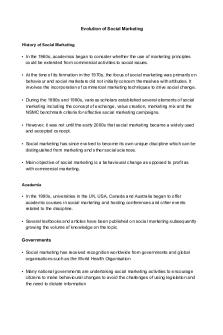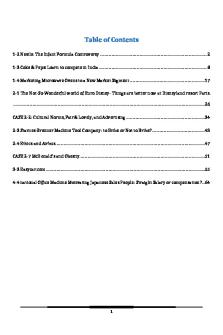The evolution of international marketing 1. Definition of “international marketing” PDF

| Title | The evolution of international marketing 1. Definition of “international marketing” |
|---|---|
| Author | alissia saquer |
| Course | Marketing Management |
| Institution | Broward College |
| Pages | 6 |
| File Size | 96.3 KB |
| File Type | |
| Total Downloads | 80 |
| Total Views | 167 |
Summary
As with many management concepts, the definitions of “international marketing” are numerous...
Description
I. The evolution of international marketing 1. Definition of “international marketing” As with many management concepts, the definitions of “international marketing” are numerous. The simplest is to qualify international marketing as the execution of at least one of the tasks of marketing, beyond national borders. For Keegan (1995, page 3, translated by us), global marketing is "... the process of optimizing resources and focusing the objectives of an organization through the opportunities of a global market". The specificity of international or global marketing would therefore lie in crossing borders, operating in a global market. Implicitly, the definitions of “international marketing” refer to the basic definitions of marketing. In a modern conception, marketing can be considered as the whole of the activities related to the management of the relation with the customer.
2. Development stages of international marketing For centuries, even millennia, peoples and cultures have traded their products. At first, it was called barter (exchange of fur for wheat), then called trade (exchange of salt for gold). Since the Second World War only, the term international marketing has been used more systematically. The commercial spirit of the merchant peoples of ancient times is basically no different from the marketing spirit of today. Both are based on the understanding of the client, the sincere consideration of his needs and wants. But marketing, in its modern conception, adds to this basic spirit a rigorous approach (for example the marketing plan) and specific techniques (for example market studies). Like “marketing”, “international marketing” is first of all an American “product”. At the end of the Second World War, American companies moved to Europe to meet European demand. Numerous American subsidiaries set up in Western Europe, notably in Great Britain and
Germany. They bring new management methods to publicize their offer in different countries, to distribute them in good conditions and thus support local demand. A second phase in the development of international marketing is linked to the oil shocks of the years 1973 and 1979. Faced with the economic crisis in the main industrialized countries at that time, international companies react in order to survive in a more difficult competitive situation: - research of new markets, in particular in the new industrialized countries (Singapore, HongKong, Taiwan and South Korea, Brazil, Mexico, ...), - refinement of international market studies in order to better understand foreign customers, - further reflection on the possibilities of standardizing the international offer and on the coordination of a wider network of subsidiaries.
The emergence and expansion of trading blocks mark the third phase of the evolution of international marketing. Stronger economic integration (for example between member countries of the European Union) further facilitates international trade. However, an increasing part of trade is now carried out within very specific economic zones. This leads many companies to establish marketing strategies, first "regional", and only secondly "global". Zones of economic integration naturally reinforce the "regiocentric" spirit of companies. The advent of the Internet marks the fourth phase of international marketing. More than ever, the Internet allows us to go beyond the “regional” logic of economic zones, and opens the way to truly global marketing. Thanks to the Internet, barriers (especially financial) to accessing world markets have been considerably reduced. A small company from a developing country is no longer cut off from the markets of industrialized countries due to a lack of resources to establish a network of distributors there. With the Internet, both supply and demand are global.
Theoretically, anyone, anywhere can share their offer and anyone, anywhere, can access (at least virtually) this offer. However, in reality, three important barriers to access to the global supply remain: - Internet access, - the skills to present one's offer in adequate form on the Internet, - purchasing power. Thus, in the short and medium term, the Internet will not really change the income disparity between poor countries (especially in the South) and rich countries (especially in the North).
II. The main theories of international trade Fundamentally, international trade is based on Adam Smith's theory of absolute advantage. At the end of the 18th century, this American economist argued that it is in the interest of one country to trade with another if there is an absolute advantage in the production of a good over the other country. Smith thus advocated, first, the division of international labor. Quickly, David Ricardo clarified, in his theory of comparative advantage, that even if a country had a relative advantage in the production of several products compared to another country, the two had an interest in trading. In such a case, it would suffice for the country producing more efficiently to specialize in the export of the product for which it had the greatest comparative advantage. Other researchers later tried to refine the basic theories, reflecting on the relative availability of factors. Heckscher and Ohlin take two factors of production into account: labor and capital. According to their “law of the proportions of factors” (also called “Heckscher-Ohlin theorem”), each country tends to specialize in the manufacture and export of goods intensively incorporating the relatively abundant factors of production in the territory , and to import products requiring the use of relatively rare factors in the country. A country with an abundant workforce would
thus produce goods that greatly require this type of factor (for example leather, wood). While a capital-rich country would produce goods requiring more of this second type of factor (eg manufacturing integrated circuits for computers, aeronautics). The difficulties Leontief (1956) experienced in 1947 in empirically validating the law of the proportions of factors for the case of the United States (“Leontief paradox”) - led to Theory of comparative advantage 3 Theory of the international production cycle Economies of scale and experience effects researchers to include other factors in their explanations for international trade.
Lindner highlights the importance of demand conditions. According to this researcher, international trade does not depend primarily on production costs (the variable on which all the previous theories focused directly or indirectly). Rather, it depends on the request conditions. The importance of domestic demand would condition the acquisition of a comparative advantage in the manufacture of manufactured products (the principle known as "representative demand"). At the same time, Lindner suggests that international trade takes place between countries whose inhabitants have a level of purchasing power, product preferences and similar requirements. This theory is the basis of modern segmentation strategies. Vernon's (1966) theory of the international production cycle also advances thinking about international trade by focusing more on the product and its place of production than on the factors of production. This theory explains why the production of (innovative) goods successively relocates from industrialized countries to developing countries. Initially, innovative
products are manufactured in highly industrialized countries, with the necessary technical capacities, skilled labor and a high purchasing power. Offered at a high price, a large part of the production is sold in the producing country, while most of the export is made to other industrialized countries. The arrival of new competitors (at the latest after the expiration of any patents) lowers prices and leads the relocation of production from high-income countries to middle-income countries. Then, when the product reaches maturity, production moves to lowincome countries. It is often controlled there by companies from industrialized countries who benefit from lower labor costs. At the end of the production cycle, a highly industrialized country can buy and sell the same type of good because its exports and imports correspond to different technological “ages”. The international life cycle model - which ultimately corresponds to a sequential introduction of products abroad - fairly well describes the behavior of investors in the period from 1950 to 1970 (and for some companies still far beyond). Today, the international product launch is rather simultaneous. This does not prevent manufacturers from taking advantage of the cost of advantageous factors in emerging countries, to ensure part of the production there. Economies of scale and experience are other factors that push companies to grow outside their home market. Observed since the 1920s in the American aeronautical industry (Wright, 1936) but more widely disseminated as a strategic model of internationalization by the consultancy firm “Boston Consulting Group” in the late 1960s only, the effects of 'experience is at the origin of a drop in production costs depending on the quantity of production of a good (cf. diagram 1.2). More specifically, it has been empirically observed that with each doubling of the cumulative production of a good, the production costs of that good fall by a constant percentage.
The relative magnitude of the decline depends on the industry involved. It can reach 30% for the aeronautical industry and is around 10% for the automotive industry. 4...
Similar Free PDFs

International Marketing
- 17 Pages

International Marketing
- 42 Pages

International Marketing
- 7 Pages

Evolution of Social Marketing
- 2 Pages

Marketing- International- Resume
- 39 Pages

International Marketing Essays
- 7 Pages
Popular Institutions
- Tinajero National High School - Annex
- Politeknik Caltex Riau
- Yokohama City University
- SGT University
- University of Al-Qadisiyah
- Divine Word College of Vigan
- Techniek College Rotterdam
- Universidade de Santiago
- Universiti Teknologi MARA Cawangan Johor Kampus Pasir Gudang
- Poltekkes Kemenkes Yogyakarta
- Baguio City National High School
- Colegio san marcos
- preparatoria uno
- Centro de Bachillerato Tecnológico Industrial y de Servicios No. 107
- Dalian Maritime University
- Quang Trung Secondary School
- Colegio Tecnológico en Informática
- Corporación Regional de Educación Superior
- Grupo CEDVA
- Dar Al Uloom University
- Centro de Estudios Preuniversitarios de la Universidad Nacional de Ingeniería
- 上智大学
- Aakash International School, Nuna Majara
- San Felipe Neri Catholic School
- Kang Chiao International School - New Taipei City
- Misamis Occidental National High School
- Institución Educativa Escuela Normal Juan Ladrilleros
- Kolehiyo ng Pantukan
- Batanes State College
- Instituto Continental
- Sekolah Menengah Kejuruan Kesehatan Kaltara (Tarakan)
- Colegio de La Inmaculada Concepcion - Cebu









